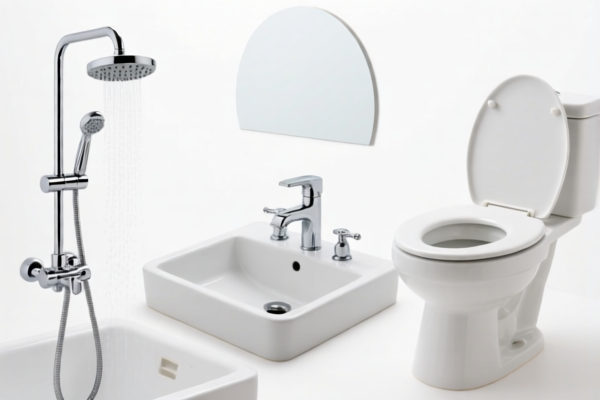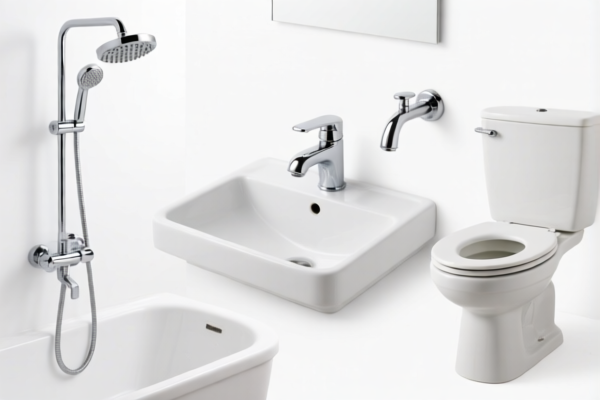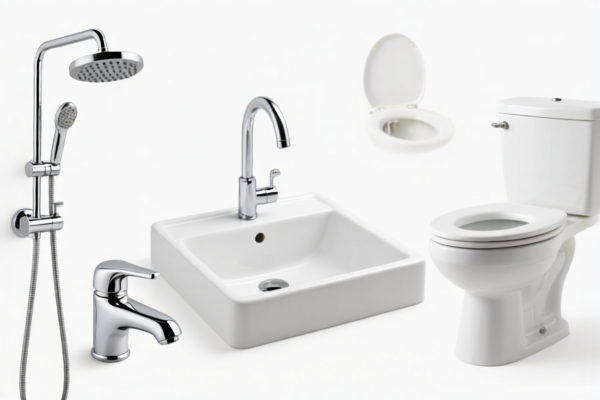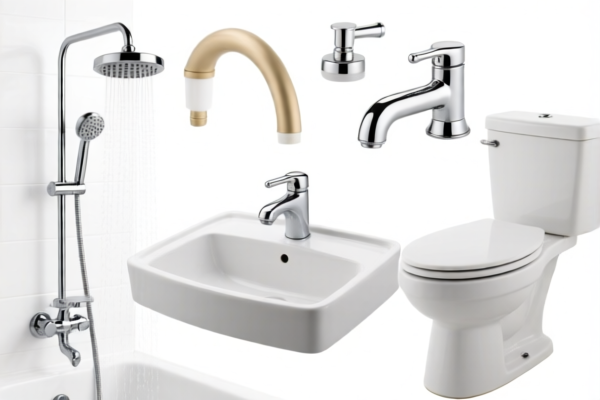| HS Code | Official Doc | Tariff Rate | Origin | Destination | Effective Date |
|---|---|---|---|---|---|
| 7418201000 | Doc | 58.0% | CN | US | 2025-05-12 |
| 7418205000 | Doc | 58.0% | CN | US | 2025-05-12 |
| 7419200010 | Doc | 55.0% | CN | US | 2025-05-12 |
| 7419805010 | Doc | 55.0% | CN | US | 2025-05-12 |
| 6910100015 | Doc | 35.8% | CN | US | 2025-05-12 |
| 6910100020 | Doc | 35.8% | CN | US | 2025-05-12 |
| 6914104000 | Doc | 55.0% | CN | US | 2025-05-12 |
| 6914108000 | Doc | 64.0% | CN | US | 2025-05-12 |




Flushing Faucet
A flushing faucet, commonly known as a toilet flush valve, is a mechanism used to discharge the contents of a toilet bowl. It controls the release of water from the tank into the bowl, initiating the flushing process.
Material
Flush valves are typically constructed from:
- Plastic: Commonly used for internal components like flappers, fill valves, and flush levers due to its corrosion resistance and lower cost. ABS plastic, polypropylene, and polyethylene are frequent choices.
- Metal: Brass and zinc alloys are used for valve bodies and components requiring greater durability and resistance to wear. Stainless steel is found in higher-end models for enhanced longevity.
- Rubber: Used for seals, gaskets, and flapper materials to ensure a watertight closure.
Purpose
The primary purpose of a flushing faucet is to:
- Rapidly evacuate toilet bowl contents: The valve allows a large volume of water to flow quickly into the bowl, creating a siphon effect that removes waste.
- Refill the tank: After flushing, the valve controls the replenishment of water into the toilet tank, preparing it for the next flush.
- Maintain water level: The valve regulates the water level within the tank, ensuring sufficient water for an effective flush.
Function
A flushing faucet operates through a series of interconnected components:
- Flush Lever: The user activates the flush by pressing a lever or button.
- Lift Chain/Flush Rod: This connects the lever to the flapper.
- Flapper: Lifting the chain/rod raises the flapper, opening the valve and releasing water from the tank.
- Fill Valve: As the tank empties, the fill valve opens, allowing water to enter and refill the tank.
- Float: The float rises with the water level and eventually shuts off the fill valve when the tank is full.
Usage Scenarios
- Residential Toilets: The most common application, found in homes and apartments.
- Commercial Toilets: Used in public restrooms, offices, and schools, often employing more robust designs for frequent use.
- RV/Marine Toilets: Specialized valves designed for smaller tanks and potentially different water sources.
Common Types
- Flapper Valves: The most traditional type, utilizing a rubber or plastic flapper to seal the opening at the bottom of the tank. These are relatively inexpensive and easy to replace.
- Dual Flush Valves: Allow the user to select between a full flush (for solid waste) and a half flush (for liquid waste), conserving water.
- Pressure-Assisted Valves: Utilize compressed air to increase flushing power, commonly found in commercial toilets.
- Gravity-Feed Valves: Rely on the force of gravity to create the flush, the most common type in residential toilets.
- Canister Valves: Feature a concealed canister design, offering a more modern aesthetic and potentially improved performance.
Based on the provided information, a “flushing faucet” can be interpreted as a sanitary fixture component related to water closets. Here's a breakdown of relevant HS codes:
-
6910100015: This HS code covers ceramic sinks, washbasins, washbasin pedestals, baths, bidets, water closet bowls, flush tanks, urinals and similar sanitary fixtures, specifically Of porcelain or china Flush tanks. A flushing faucet component integrated with a flush tank would fall under this classification. The two-digit sections represent:
- 69: Ceramic articles.
- 10: Sinks, washbasins, washbasin pedestals, baths, bidets and similar sanitary fixtures.
- 0015: Specifically, flush tanks made of porcelain or china.
-
6910100020: This HS code also covers ceramic sinks, washbasins, washbasin pedestals, baths, bidets, water closet bowls, flush tanks, urinals and similar sanitary fixtures, but classifies Of porcelain or china Other water closet bowls. If the flushing faucet is an integral part of a water closet bowl (ceramic), this code may be applicable. The two-digit sections represent:
- 69: Ceramic articles.
- 10: Sinks, washbasins, washbasin pedestals, baths, bidets and similar sanitary fixtures.
- 0020: Specifically, other water closet bowls made of porcelain or china.
-
7418201000: This HS code covers Table, kitchen or other household articles and parts thereof, of copper; pot scourers and scouring or polishing pads, gloves and the like, of copper; sanitary ware and parts thereof, of copper: Sanitary ware and parts thereof: Of copper-zinc base alloys (brass). If the flushing faucet is made of brass, this code may be applicable. The two-digit sections represent:
- 74: Copper and articles thereof.
- 18: Table, kitchen or other household articles and parts thereof, of copper.
- 201000: Specifically, sanitary ware and parts thereof made of copper-zinc base alloys (brass).
-
7418205000: This HS code covers Table, kitchen or other household articles and parts thereof, of copper; pot scourers and scouring or polishing pads, gloves and the like, of copper; sanitary ware and parts thereof, of copper: Sanitary ware and parts thereof: Other. If the flushing faucet is made of copper but not brass, this code may be applicable. The two-digit sections represent:
- 74: Copper and articles thereof.
- 18: Table, kitchen or other household articles and parts thereof, of copper.
- 205000: Specifically, sanitary ware and parts thereof made of other copper materials.
Important Note: The total tax rate for HS codes 7418201000 and 7418205000 is 58.0%, with a base tariff of 3.0%, an additional tariff of 25.0%, and an additional tariff of 30.0% after April 2, 2025.
Customer Reviews
No reviews yet.